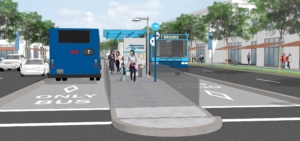Bus rapid transit (BRT) system activities should not be overlooked if partnering with the government is of interest. This is a ‘hot’ marketplace for contracting and collaboration.
Opportunities will include, but not be limited to, initiatives that enhance and make route schedules more efficient, convenient and appealing. The construction of sheltered wait stations, real-time mapping and leading-edge technology will be required. BRT projects are becoming increasingly common in metropolitan areas due to traffic congestion. Rapid transit buses have become the go-to solution instead of old, inefficient bus systems and very costly light rail systems.
Some of the country’s largest municipalities have recently delivered BRT projects and their successes are now models for similar projects. Successful projects in San Francisco and New York included exclusive bus lanes that reduce travel time along busy corridors, and while other drivers hate the dedicated lanes, the time-saving factor is working to keep people off the street in individual vehicles.
BRT projects are also taking cues from cities like Denver and Boston about how to upgrade their bus systems to ensure more frequent service, easier transfers and broader coverage. Everything possible is being done to make public transportation more attractive and enticing for riders.
Technology firms should monitor upcoming projects because all transit projects now require an abundance of new technology. Data monitoring programs are being integrated into design concepts to minimize wait times and increase efficiency. Traffic signal priority systems, off-board fare payment equipment, automatic vehicle location systems and other technology assets are common in all recent BRT proposals.
Federal funding for BRT projects will continue to be significant because of carbon reduction benefits and the critical need to reduce traffic congestion. The Federal Transit Administration’s grant program was recently expanded and funding of up to 60% of the cost is available for transit projects that will require more than $400 million. Other types of funding awards offer up to 80% coverage, have no lane dedication requirements and are designed to support projects that cost less than $400 million. There is funding available also for projects that are delivered through a public-private partnership. This funding option is designed to encourage private-sector investment in the country’s infrastructure.
In March, the Federal Transportation Administration (FTA) announced $4.5 billion in annual funding through newly expanded funding programs. Already announcements have been made about funding allocations to support 18 projects in 11 different states. Meanwhile, here are the types of contracting opportunities that will be available soon.
A $400 million project will soon be launched in Montgomery County, Md. Officials will expand BRT services while improving speed, reliability, convenience, and comfort for riders. Routes will be expanded to provide access to the county’s local college campuses, jobs, healthcare services, housing options, and light rail networks.
Officials in Washington County, Ore., will launch a $105 million transit project. A steering committee is providing input for the design of a new rapid transit option along the Tualatin Valley Highway. While initial cost projections are approximately $105 million, that estimate has now increased due to inflation and supply chain complications. The design concept for the project will align with regional transportation goals by delivering a much safer and more efficient bus system.
The transit authority serving Seattle, Wash., is also designing a new BRT line and this effort will carry a cost estimate of $2 billion. It will feature a fleet of battery electric buses to provide service between new stops at 10-minute intervals. Other project components will include multiple-door bus entries, off-board fare collection systems and dedicated lanes. The bus line will provide connections to regional light rail networks, a regional transit center and 1,300 new parking spaces.
Local leaders in New Orleans recently voted to advance work on what will be the city’s first BRT line. The transit option will improve access for the city’s most underserved eastern and western communities by enabling mobility to services and businesses in New Orleans’ bustling downtown district. In late March, the city approved a preliminary plan for the BRT project that has a projected cost of $300 million for the first phase of construction.
In Pittsburgh, Pa., the transit authority has approved a project to extend BRT services to a designated business improvement district in the city’s Oakland community. Initial construction plans include five new bus stations, dedicated bus lanes and a new fleet of electric buses. New transit links will be provided for 100,000 commuters who travel through heavily congested areas of Pittsburgh daily. Once pre-development work is underway, transit officials will launch the project’s second phase of construction projects in 2024. A recent announcement by the regional transit authority outlined plans to spend $1 billion over the next two decades electrifying its fleet of buses.
Mountain Line, the public transit authority in Missoula, Mo., received $1 million to launch the development stage for a new BRT line that will serve the city’s heavily trafficked downtown corridor. The transit authority is partnering with local stakeholders to incorporate benefits for economic development and expanded housing options near stations into the plan. The project will cover a span of approximately six miles and cost projections will be available as soon as the design phase is completed.
Preliminary work has begun on several large BRT extension projects that will emphasize community development in Fulton County, Ga. Local announcements stated that a partnership to expand existing BRT lines is now identifying design alternatives and sites for upcoming construction of new BRT stations along a corridor in northern Fulton County. The project’s final design will encourage transit-oriented development around new stations, provide improved last-mile connectivity and encourage other new developments.
With billions of funding available for the expansion of rapid bus systems, companies with services that will be in high demand are advised to check out planning initiatives in all regions where they are located. The next decade of projects will require goods and services that can only be provided by private sector firms.








